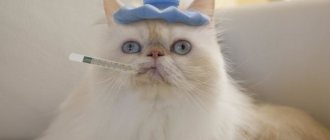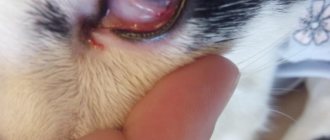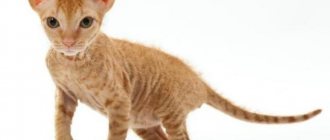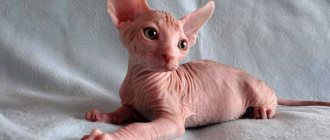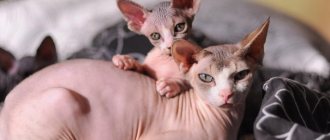Low or high body temperature in sphinxes can signal serious health problems that need to be eliminated as soon as possible with medications. If the temperature does not stabilize over the course of several days, and the cat experiences fever, fever, nausea and other unpleasant symptoms, then you should not delay contacting the veterinary clinic.
What is normal temperature?
The Canadian and Don Sphynx have the same body temperature as other breeds of the cat family. Many owners believe that a cat’s normal temperature should be 42 degrees, but this opinion is erroneous. Such speculation arose due to the fact that when you touch the skin of the sphinx, it is very hot. The normal temperature for this breed is 38-39 degrees, and anything lower or higher than normal is pathological.
Veterinarians note that the temperature of Sphynx kittens may be slightly higher than that of adults by 0.5 degrees. This is explained by the active processes of growth and development in a young body.
Owners should regularly monitor their thermoregulation, as this is a problem area for Sphynx cats due to their lack of fur. It is especially important to monitor the body temperature of young cats, since kittens are not able to carry out normal thermoregulation and even if it is 18 degrees in the house or outside, they can become hypothermic and get sick. If the case is advanced and veterinary care is not provided on time, the sphinx may die.
In winter, animals look for cozy, warm places, and in the hot season, on the contrary, cool ones.
Adults are able to regulate the heat exchange of their own body, and in winter they hide in warm places, and in summer they try to find coolness. All Sphynx owners should know that it is not recommended to expose them to drafts, as there is a high risk of hypothermia. Against the background of a significant decrease in temperature, the cat develops rhinitis, laryngitis, and pneumonia.
Myth four. Sphynxes are Egyptian cats.
Despite the fact that Sphynxes are associated with Egypt, the breed that we are used to seeing was bred in Canada, and that is why its name always has the prefix “Canadian”. There are no Egyptian sphinxes (except, of course, for the famous architectural monument!), this is just a myth, like most myths about animals, although, of course, hairless cats lived in ancient times. Certain types of such animals were found among the Aztecs and later they were called Mexican hairless cats - they were brought to America and then to Europe from Mexico.
They were naked most of the time, but in winter long hair grew on their body, which lasted until it warmed up. They were demonstrated at the first cat exhibitions of the 20s of the twentieth century. in the USA, and the last pair of such animals lived until the 30s, but, unfortunately, did not leave offspring. It was then that she was replaced by Canadian Hairless cats, which today are the kings of all exhibitions and the favorites of numerous breeders.
Hairless cats with Canadian “registration” appeared 40 years ago and almost immediately conquered the world. However, there are other types of sphinxes:
-Don Sphynxes - bred in Russia and can be called Russian hairless in another way,
-Petersburg Sphynxes - also bred in Russia, but in the special conditions of the harsh St. Petersburg climate (they can also be called Peterbald).
Myth fifth. Sphynx cats were bred using genetic engineering in a laboratory.
The bareness of sphinxes is the result of a natural mutation. The first naked cats were found literally in a garbage dump by compassionate people; they were treated for lichen for a long time and unsuccessfully, until they realized who was really in front of them.
Signs of hypothermia
A low temperature in a Sphynx can be fatal if the owner does not notice the problem in time and does not contact a veterinarian. When hypothermia occurs, the temperature drops to 37 and below; the critical mark on the thermometer is 28. Pathology can be recognized by additional symptoms:
- weak palpation of the pulse;
- rare breathing;
- pale mucous membranes and skin;
- trembling in the muscles of the Sphinx;
- poor sensitivity;
- lethargic and apathetic state;
- wide pupils.
Reasons for the drop in temperature
- Coldness. After being in the cold for a long time, it manifests itself in cats. Most often found in kittens and older cats.
- Improper functioning of internal organs. Due to disruption of the circulatory and endocrine systems.
- Viral diseases. Weakening of the body or refusal of food contributes to hypothermia.
- Parasites. Because of helminths, anemia develops and the functioning of the circulatory organs deteriorates.
Average body temperature of a cat
How to help your pet and raise the temperature?
You can stabilize body temperature after hypothermia by covering your pet with a warm blanket.
If the owners find symptoms of hypothermia and a low temperature in the Sphinx, then they need to know how to help their pet at home. First you need to wrap your pet in a warm blanket, blanket or towel to warm him up and stabilize his temperature. Place the sphinx in a chair or other warm corner. In case of severe hypothermia of the cat's body, apply a heating pad to the cold back of the animal. If possible, it is recommended to give the cat warm water to drink. When he refuses to drink the liquid on his own, you can try to inject it into the animal using a syringe. It is worth monitoring the condition of the sphinx and if there is a significant decrease in temperature and pathological signs, it is necessary to immediately take the pet to a veterinary clinic.
Myth three. Sphinxes are very difficult to care for and maintain.
I often get asked questions: Is it true that sphinxes need to be bathed every day? Is it true that Sphynx cats need to have their ears cleaned every day? Is it true that sphinxes need to lubricate their skin with oil or cream? Is it true that sphinxes get very cold and need to be dressed? No it is not true! Of course, sphinxes need to be bathed from time to time, but only when they get dirty, and healthy sphinxes that are on a proper and suitable diet practically do not get dirty. Of the five sphinxes that live with me, two can be bathed once every six months, three once a month. The ears of sphinxes get dirty faster and more than those of ordinary cats, this is true, but healthy sphinx ears require cleaning once every two weeks; if the ears get dirty faster, then it is necessary to reconsider the diet, since the food itself is not inappropriate and/or too fatty The Sphynx and its ears can get very dirty; it is also necessary to show the Sphynx to a veterinarian and get tested. Just be careful with veterinarians, too; many veterinarians, without knowing the specifics of the breed, diagnose ear mites and heal the poor Sphynx. Therefore, first of all, get tested and do not take the veterinarians’ word for it! The skin of the Canadian Sphynx does not need any creams or oils. Canadian Sphynxes are not greenhouse animals, so they also do not need clothes for the house. I have clothes for each of my pets, but we only wear them on the road during the cold season and take them to exhibitions, since sometimes it gets too cold in large halls. At home my sphinxes don't wear any clothes. And there is no need for them.
Fever: symptoms
Various diseases, overheating and other factors can affect the increase in temperature of the Sphinx. As a result, the temperature rapidly increases to 39 degrees and above. This condition of a pet should not be left unattended, as it can cause serious complications and can cause the death of the pet. Heat stroke can be recognized by the following clinical picture:
- frequent breathing and shortness of breath for no particular reason and at rest;
- the sphinx breathes through her mouth, with her tongue hanging out of her mouth;
- insufficient depth of inspiration;
- delirious state, the pet is looking in an unknown direction;
- disorientation in space;
- changed color of the mucous membranes, which can be from rich color to whitish;
- weak pulse, and heartbeats are almost impossible to count.
At elevated temperatures, the sphinx is constantly in a lying position, and it is difficult for him to make any movements. When the owner calls him, there is no reaction.
Buy a Don Sphynx kitten
Don cats are very capricious and demanding creatures in terms of self-care. Breeders strongly recommend taking kittens from nurseries. This method of purchasing a pet guarantees that the animal will be vaccinated, healthy both physically and mentally, trained to look after itself, use a litter tray, and, which is also important, with documents.
The average price for a Don Sphynx kitten fluctuates around 15,000 rubles
. The cost depends on many factors: pedigree, title of the parents, whether the kitten is sterilized, etc.
What to name a Don Sphynx cat
global $ads_google;
//data-ad-slot=”2475549904″ $ads_google = empty($ads_google) ? false : true; ?> if ($ads_google == false) {?> $ads_google = true; ?> } ?> When buying a small Don kitten, in addition to various accessories, you need to come up with a name for it.
You can give a nickname based on the lack of fur or movie character, character and habits in the first days of living in a new place. The name for the Don Sphynx is an important part of his life; he will respond to it and run headlong when he is called. Nicknames for Don Sphynxes
| Girl | Boy | ||
| Tusya Knopa Tisa Ilga Donna Mickey Ocher Dora Sherry Lala Skin Sana Barbie Emmy Zola | Zarya Una Chris Manyasha Pinky Rat Zurna Patya Shila Riza Vita Piper Lysya Naida Mosya | Indie Bigglesworth Tori Rabo Elik Ferry Casper Samur Green Adams Chivas Rino Arno Kid Ozzy | Grimm Achilles Barry Yut Dionysus Luchik Amon Peach Frankie Ra Apricot Pursh Marsik Bes Dons |
Conclusions about the breed
To summarize, let us pay attention to the advantages and disadvantages of Don Sphynx cats.
- Donetsk cats are companion cats. They are peaceful and tolerant of other pets. Suitable for families with small children. They rarely bite or fight. Although, of course, there are some wayward, capricious individuals with character.
- Healthier than other hairless cats. But they also require careful, regular care. Their hairless skin is thin and delicate, the temperature of the coat is higher than that of ordinary short-haired cats. You need to make sure that the cat is not exposed to cold; he must have a place where he can warm up at any time. In summer, dosed sunbathing will be useful.
- The Don cat does not cause an aggressive allergic reaction. In addition, sphinxes are real “healers”.
How to bring down the temperature?
At home, a wet towel in which the cat is wrapped will help reduce the indicators.
If your pet has a very high body temperature and pathological symptoms are observed, it is recommended that you contact a veterinarian as soon as possible. The clinic will conduct a diagnosis, find out the reasons for the increase in temperature and select a treatment that will help bring down the readings on the thermometer and eliminate the underlying disease. At home, it is possible to alleviate the condition of a pet by performing the following actions:
- Wrap your pet in a wet towel or blanket to reduce symptoms of heat stroke.
- Carefully wipe the sphinx's face and ears using cotton pads.
- Place the animal in a cool place, but not too cold, so that sudden hypothermia does not occur.
- They try to give him cold liquid to drink. You can use an ice cube that your cat can lick.
Even if using home methods it was possible to bring the cat’s temperature back to normal, you should contact a veterinary clinic, since such a case is the first sign of serious illness in the animal. With advanced overheating, this type of cat has a high risk of swelling of the brain and lungs. Elevated temperature is especially dangerous for kittens, which may die if their condition is not stabilized in a timely manner.
What do sphinxes get sick with?
Hairless Sphynxes are now a fairly popular cat breed.
Despite their apparent fragility, they rarely get sick due to their elevated body temperature. Most often - hereditary diseases. Causes of diseases
First of all, as already mentioned, it is heredity. Heart disease, myopathy, airway obstruction - unfortunately, sphinxes are genetically predisposed to all of this.
As for other diseases, cats usually become infected with them from sick animals, through direct or indirect (using the same care items, food as infected animals) contact, parasites, or even humans. Sometimes hormonal imbalances play a role.
A relationship with color was also revealed - blue and blue-cream cats get sick most often.
Diseases and symptoms
Sphynx cats, like other cats, are very patient and do not come to the owner to “complain.” Therefore, you need to carefully monitor the appearance of the following symptoms:
- lethargy and exhaustion;
- loss of appetite;
- weight loss;
- vomit;
- diarrhea or constipation;
- thirst;
- blood in stool;
- itching;
- cough;
- bloating;
- atypical behavior - aggressiveness, anxiety.
All this can be symptoms of a number of diseases, including:
- hypertrophic cardiomyopathy - a heart disease that can lead to sudden death;
- hereditary myopathy – muscle dysfunction causing muscle weakness;
- airway obstruction – loss of the ability to swallow food.
There are diseases that are easy to notice by external signs:
- cystic mammary hypertrophy – development of mammary tumors;
- vasculitis - inflammation of the walls of blood vessels, in which spots appear on the skin of the Sphinx with possible subsequent transformation into ulcers;
- microphthalmia - abnormal development of the eye, when it is underdeveloped, but is still present, the consequence of which is poor vision or even blindness;
- nipple hyperplasia - deformation of the nipple with the possible development of a cyst;
- acne – the appearance of blackheads;
- shortening of the lower jaw - a malocclusion when the rows of incisors do not align, which makes eating difficult;
- Congenital entropion of the eyelids is an inversion of the edge of the eyelid and eyelashes, causing redness and lacrimation.
Diagnosis and treatment
Many diseases of sphinxes are diagnosed by visual examination. If we are talking about damage to internal organs, then standard tests for such cases are prescribed - blood tests, x-rays, ultrasound.
Most often, drug treatment is prescribed - antibiotics, ointments, serums. But doctors also have to resort to surgery, for example, in the case of nipple hyperplasia, when the tumor has to be removed.
Alas, some diseases of sphinxes are incurable and relapses may occur, or the animal’s normal condition must be maintained with medications.
Prevention
First of all, to prevent diseases of sphinxes, it is necessary to vaccinate cats on time and avoid contact with infected animals.
Cats need to be bathed once a week or they may develop skin diseases and remember to remove secretions from the ears. Animals also need their teeth brushed once a week.
Sphynxes are affectionate and friendly pets that are the joy of any owner.
Reduced body temperature in cats
If a pet's temperature is below 37C, this condition indicates problems in the animal's body.
Causes of hypothermia:
- depression, drowsiness, apathy;
- chills, muscle tremors;
- anemia of the mucous membranes;
- viral, bacterial diseases characterized by immunosuppression;
- malignant neoplasms;
- pathologies of the cardiovascular and nervous systems;
- chronic renal, liver failure;
- hypothermia of the body;
- bleeding.
If the temperature is low, the cat will look for secluded, warm places. The cat becomes inactive and depressed . The cat reacts reluctantly to external stimuli; slight trembling is noticeable. With a significant decrease in physiological temperature indicators (up to 36 degrees), metabolic processes and heart rate slow down, and blood pressure decreases. Breathing becomes rare and shallow. The cat is breathing heavily and wheezing can be heard. In veterinary medicine, such a condition is characterized as shock, so it is very important to provide assistance to your pet as quickly as possible.
Feeding
Hairless cats spend slightly more energy maintaining their temperature than furred cats. They have to compensate for the lack of a fur coat with extra calories, because a body unprotected by fur gives off heat faster. Therefore, they have a good appetite, which often turns into a tendency to overeat.
The Don Sphynx is a cat with unusual tastes: nuts, fruits, mushrooms, baked goods and chips. Coupled with a good appetite, the desire to try everything leads to indigestion, obesity, and allergies. Feeding errors affect the skin - rashes, scratching, increased oiliness or, conversely, dryness to the point of flaking.
The breeder will tell you what to feed the Don Sphynx kitten for the first time. They digest natural food and prepared feed equally well. The diet must be followed for at least a month. They switch to a different diet only after adaptation, drawing up a menu together with a veterinarian.
It is important to monitor the portion sizes and all family members - sphinxes are masters at begging for an extra piece. And, despite their apparent clumsiness, they climb deftly and quickly learn to open cabinets with their paws. Food, cookies and other goodies should be securely stored in jars with tight lids - the cat will chew through the bag in no time.
First aid for a pet
If your pet’s temperature has risen to 39.5-41 degrees, it is urgent to take appropriate measures aimed at normalizing the furry pet’s condition.
Contact your veterinarian for help. Only a qualified specialist can establish the root cause of hyperthermia, determine why the temperature is elevated and why the cat feels unwell, after conducting a comprehensive diagnosis.
If the temperature is very high, the cat feels unwell, before the veterinarian arrives or visits the veterinary clinic, to alleviate the condition of the fluffy, lightly moisten the fur with cool water. Apply a cold compress to the inner thigh, ice cubes on the neck, scruff. The cat should be placed in a cool place. Provide plenty of fluids. If the cat refuses to drink water, pour small portions into the animal's mouth with a syringe without a needle.
In case of hypothermia, if the temperature is low, cover your pet with hot water bottles and wrap the animal in a warm woolen blanket. The cat should be kept warm, away from drafts and heating appliances. Ensure maximum peace. You can give warm sweet tea, chamomile decoction.
If the condition does not return to normal, the temperature is low, take your pet to the veterinary clinic. Animals are given oxygen therapy and given intravenous infusions of warm solutions. Constant monitoring of temperature indicators is carried out until the general condition stabilizes.
After treatment, follow all recommendations of the treating veterinarian. Provide proper care. Do not self-medicate if you do not want to aggravate the situation or provoke serious complications. Therapeutic therapy and treatment regimen should be prescribed by a veterinarian.
Story
In the winter of 1986, Elena Kovaleva noticed boys throwing a bag to each other.
Inside, a kitten squeaked pitifully - the compassionate girl could not pass by. So an ordinary tortoiseshell noblewoman, named Varvara, by chance became a domestic cat. Soon the owner suspected that something was wrong with the pet: without any symptoms of illness, the fur coat began to thin out. Soft, slightly twisted hairs broke and came out in clumps, as if caused by a fungal infection. But neither numerous tests nor complex treatment regimens yielded results.
In 1988, Elena met Irina Nemykina. She recognized the funny pet, half devoid of hair, as a real sphinx. This was surprising, because even in Canada back then hairless cats were considered exotic. And in Rostov-on-Don! The find was shown to experts, but then no one was interested in it.
Later, Varvara’s mating with an outbred cat proved that it was a matter of genetics. The cat Chita was born like her mother - with a sparse fur coat, a bald spot on her head, and a shaggy “squirrel” tail. Like Varvara, she began to shed her fur. Elena gave Chita to Irina, who dedicated her life to working on the new breed.
The following matings confirmed the dominant nature of the mutation. It became clear that this was a unique find, and not a repeat of history with the Canadian sphinxes. Foreign naked cats carry a recessive gene; when mated with ordinary cats, there are no hairless offspring.
Breed varieties
According to the degree of hair growth, there are 4 “subspecies” of Don sphinxes. Cats in the same litter give birth to different kittens, regardless of the type of fur of the parents or its complete absence.
1. Brush is covered with a rare “shaggy” coat. According to the degree of distribution of thick areas and bald spots, any options are possible. With age, the Don Brush becomes completely bald or, conversely, gains volume to an almost full fur coat.
2. Velor – even in the photo, Don Sphynx kittens of this type have short hair visible. Hairs 2-3 mm long cover almost the entire body or grow only on the head, paws, and tail. Growing up, such a cat undresses or becomes overgrown - a lottery.
3. Flock - delicate thin fluff is noticeable only up close. In the photograph and when viewed from the side, the body appears naked (visible hairlessness). Growing up, he strips down to his velvety “peach” skin. Many people want just such a Don Sphynx cat, because it is pleasant to touch: the palm glides freely over the body, there is no feeling of grease.
4. Completely naked, “rubber” kittens are born without any hair at all. A valuable addition to the nursery, judges give preference to them at exhibitions. True, the sticky “waxy” skin that gathers in folds under the hand is very specific.
Breeders advise choosing a hairless Don Sphynx kitten not by photo, but by touch. This is the only way to understand which variety you like best. Apart from having a funny shaggy coat, the brushes fully comply with the standard. They are used for breeding without awarding titles.
Hyperthermia in cats
The mechanism for increasing the temperature of the animal body is based on an imbalance between the process of heat generation (heat production) and heat transfer. The balance can be disturbed under the influence of unfavorable ecto and endofactors of various natures.
- overheating, heat stroke;
- the presence of pathogenic flora in the body that provokes viral-bacterial, parasitic diseases, systemic pathologies;
- development of inflammatory processes;
- poisoning, severe intoxication;
- disruption of the functioning of internal organs;
- exacerbation of chronic pathologies;
- an excess of salts in the body, which leads to increased breakdown of proteins and metabolic disorders.
In small kittens, an increase in temperature by one or two degrees above normal can signal the presence of endoparasites and the development of helminthic infestation.
Important! Elevated temperature in infectious and viral diseases is a physiological protective-adaptive reaction. If a cat suffers from diseases of non-infectious etiology, temperature readings may also be elevated.
- lethargy, apathy, drowsiness;
- rapid breathing, shortness of breath;
- disruption of digestive processes;
- increased thirst;
- rapid pulse, palpitations, high blood pressure;
- convulsions, muscle spasms, fever.
The cat refuses food and favorite treats and is in a depressed state. Possible severe vomiting and diarrhea.
This is interesting: How do Sphynx cats mate?

